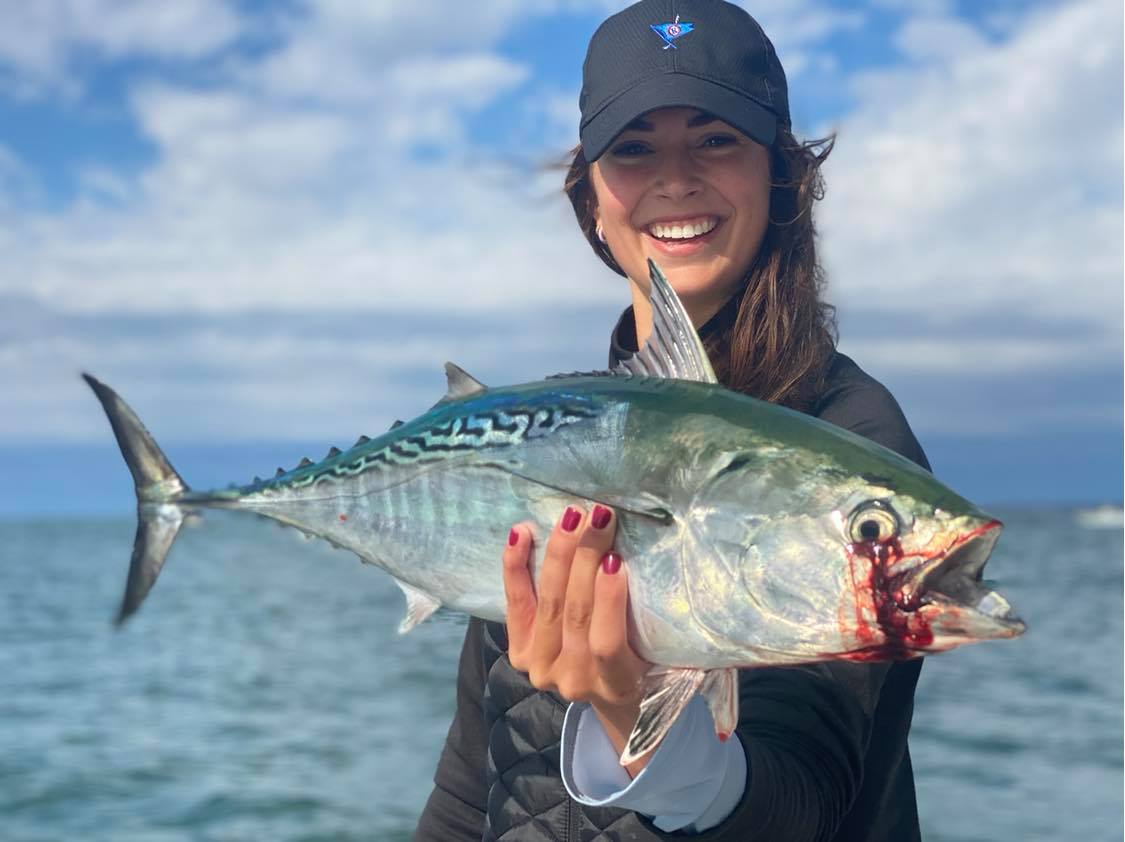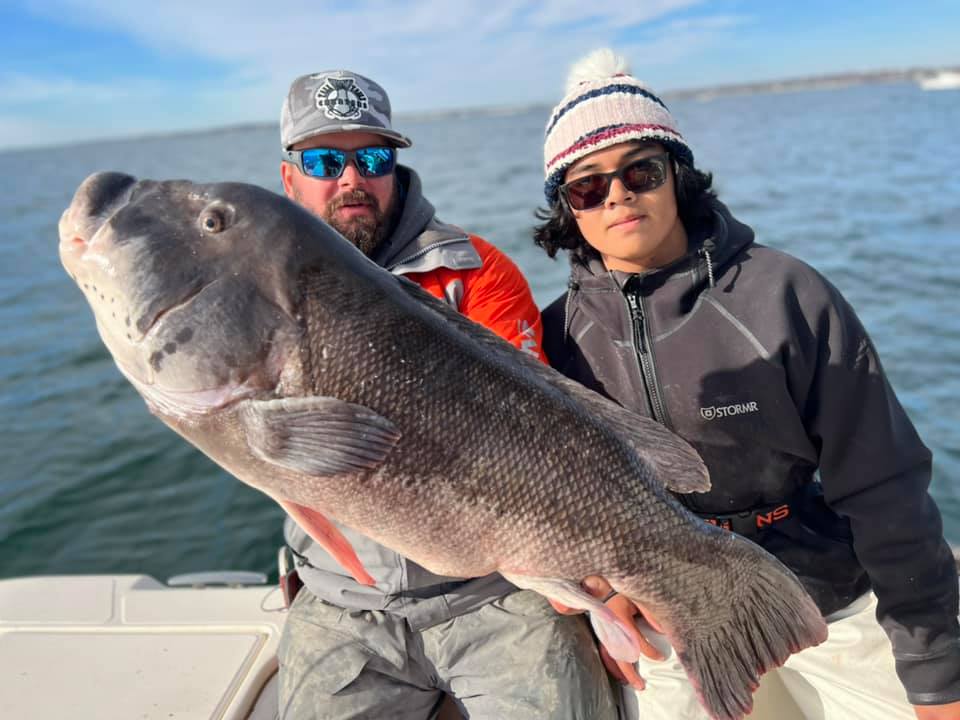Treating Albie Fever
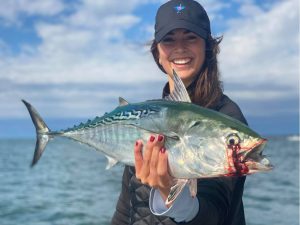
As the summer days start getting shorter and the evenings start getting cooler, there is a unique energy shift that takes place in the inshore waters of Rhode Island. The hot and lazy days that make up the “doldrums of summer” begin to morph into the first days of New England’s legendary “fall run”. While most folks are excited to sip pumpkin spice lattes and go apple picking, and rock turtlenecks, I’m getting pumped for the arrival of our seasonal hard tail visitors and all of the fun that accompanies them. As the summer starts turning to fall, massive amounts of bait start flushing out of the bays and inland waterways. It isn’t soon after that our coastal waters are filled with hungry predators looking for an easy meal. False albacore, green bonito, Spanish, chub, and frigate mackerel come in from offshore and offer some of the best light tackle fishing opportunities one could imagine. The false albacore, fat Albert, or “Albie” is the most sought-after species amongst the hardtails. They are known for their blistering runs and immense power for their size. While they can sometimes be ferocious feeders and eat anything you throw at them, there are other times they will not even sniff your bait. They are rightfully known as “the fish of 1,000 casts” and at times can humble even the best anglers. My fishing charter outfit, Tall Tailz Charters specializes in this light tackle approach and we typically do a few dozen trips a year targeting these fish. In this article, I’ll go over a few different strategies and methods I’ve developed to give you the best shot of hooking up with these speedsters.
How, where and when do you locate False Albacore?
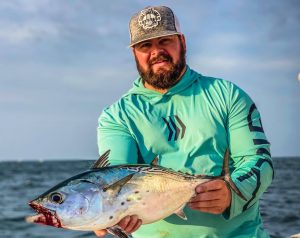
To have a successful day of Albie fishing you must do several things right. The first and most obvious step is to find the bait and find the fish. However, this can be more difficult than it sounds. The most common style of fishing for albies is a “run and gun” approach where you locate fish feeding on the surface and move accordingly to keep your boat in position and within casting range of the fish. The trick is finding them while they’re feeding on the surface, or picking up clues that a feed has happened or will happen. Let’s start with some of the tell-tale signs. The most obvious signs are of course, witnessing these fast moving, football shaped predators busting out of the surface while chasing bait. From a distance you’ll be able to see a number of splashes, seemingly moving in one direction with torpedo like silhouette’s in the waves. Typically, birds will accompany these feeds as they fly close to the water, darting in and out, attempting to pick off some of the bait fish being corralled to the surface. Working birds and visible splashes will be your number one sign of an albie feed, especially from a distance. But what if there are no visible surface feeds happening? Fear not, there are still important clues that can tell you what’s going on under the surface. Birds will still be your friend even if a feed isn’t happening at that moment. Be on the lookout for birds laying dormant on the surface, just hanging out. Sea birds are opportunistic hunters and will have good reason to congregate in one area. A feed may have just ensued, but the bait may have made a run into deeper water or completely dispersed. In this case, the birds are waiting for the albies to ball the bait up again and force them back to the surface. If you see any of the birds with their heads down looking into the water, get ready because this is a good sign that there is bait and fish working them underneath. Sometimes false albacore schools can be small or scattered and without any birds on them at all. In situations like these, keep an eye out for shimmering or “nervous” water where bait may be at the surface but not currently being harassed. Another important clue to look for are slicks in the water. False albacore are a member of the mackerel family and like mackerel, are extremely oily. Not only are the albies oily, but many of the types of baitfish they target are as well. If you spot an area with a pronounced slick, especially if its rather narrow, there’s a good chance that it’s a trail left behind from feeding albies. The final helpful hint is to simply stay informed. Try to work with a network of other anglers and share intel. Keep a logbook each year and look back for reference, as these fish do tend to repeat certain patterns each season.
What gear should you use to catch False Albacore?
The most common set up for albie fishing is a light tackle spinning outfit. The perfect albie set up needs to check a few boxes. The rod needs to have a fast or moderate fast action with a responsive tip when casting and for shock absorption on initial strike. The ideal rod should be a medium power, possibly medium light with a strong enough backbone to throw heavier jigs up to 3-4 oz, while maintaining a fun, parabolic flex. In short, the right albie rod should be strong but not overly heavy with a responsive tip. I like the feel and performance of the Daiwa Harrier, 7’ MF and the Jigging World Nexus 7’ MF. The team at Crafty One Customs in Portsmouth, RI can set you up with either of these rods or build you an incredible custom rod from the blank up. Any tough saltwater spinning reel in the 3000-5000 class with at least 15 lbs of drag will do nicely. This year I paired my albie rods with the new Daiwa BGMQ 4000’s and it’s a match made in heaven. I spool them with 30 lb J-Braid X8 Grand in light grey. For leader connection I avoid any shiny swivels or terminal tackle that may spook fish and instead tie a modified FG knot directly from the line to a 4-6’ fluorocarbon leader. Albies can be very finicky at times and I will adjust leader size based on conditions and how the fish are behaving. We prefer Cortland line fluorocarbon anywhere from 15 lbs to 40 lbs. I typically start at 25 lbs and will go a little lighter if water clarity is particularly good or the fish are being fussy. I will generally only go up to 30 or 40 lb if the fish are feeding aggressively, are not leader shy and I want to catch multiple fish without worrying about changing the leader. My favorite knot to tie lures and jigs to is always the palomar knot. However, a simple improved clinch will suffice as well.
What types of bait do false albacore eat?
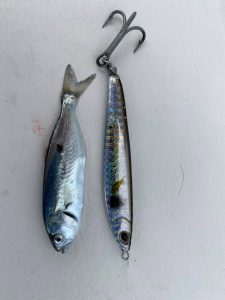
Its amazing the amount of bait false albacore eat. What’s even more amazing is WHAT they eat. Sometimes they’ll be feeding on whatever swims in front of them and other times they’ll be honed in on 1” rain bait and will not eat anything else. Their typical meals of choice are peanut bunker, silversides, sand eels, bay anchovies, half beaks, juvenile herring and shad. The truth is, you never truly know what these hungry fish will be feeding on each day. A common phrase you’ve probably heard is “match the hatch”. This expression is true: figure out what bait the fish are feeding on and try to replicate the size, color and action. As a rule of thumb, start small as most of the baits albies feed on could fit in your hand. If I don’t know what the fish are feeding on, I will typically start with a small metal jig, 3-4”/1-2 oz. in a neutral silver or light blue finish. A common retrieve is quick with sudden pulses to resemble a wounded bait fish desperately fleeing. The perfect casting jigs that can fit a number of bait profiles are the Daiwa zakana jig, (20-60 gram) and Williamson Gomame and Gomoku jigs. (1-3 oz). You can adjust the size and color once you’ve identified which type of bait they’re feeding on. When false albacore are feeding on larger baits like sand eels or half beaks I like to use Daiwa sp minnow, (silver or sardine) albie snax, (white or pink) or small 4-6 inch ron-z lures (white, olive or silver). I’ve seen these fish eat 9” topwater striper lures and eat a 1” fly. Sometimes they want to eat what you offer and sometimes they don’t; All you can do as the angler is be prepared and persistent.
How do you catch false albacore?
Once you’ve located the general area that the albies are working and you’ve got the right gear rigged and ready, it’s time to get a bite and let the fun begin. If you’re lucky, you’ll have a few pods of fish all to yourself and can pick and choose where to cast. But, in most cases, other boats will be in the area and can make a would-be enjoyable day rather stressful. Inexperienced or throttle happy boat operators will speed over to the fish, often times running them over and sending them back down until they (hopefully) re-group again. Other times boaters will blast over to breaking fish only to block your casting angle and muddle a perfect hook up opportunity. Your best bet is to slowly throttle over towards the feed and when your almost within casting range, turn off the engine and drift stealthily towards the direction the fish are moving. More often then not, you’ll see a feed, move the boat, then watch the albies go back down just as you’re ready to cast, only to see them pop back up where you just were! The best advice I can give is to only move the boat out of necessity. If multiple pods of fish are busting on either side of the boat but are out of casting range, don’t stress. Be patient, keep the boat where it is and these fast moving fish will almost certainly pop up near your boat, usually when you least expect it. If the fish are down and in between surface feeds, keep casting. Easily 50% of the hooks up we have on these fishing charters are on blind casts in between feeds. Try varying your depths and speed of retrieval when the fish are down. While we’ve had plenty of success blind casting and casting directly into a feed, your best odds to hook up are when you place a cast just ahead of the direction the fish are moving. This can separate your lure from the mass of bait, yet still be within range and will usually lead to a strike. While it may sometimes be frustrating as you watch other boaters cut you off or run over fish, try your best to be respectful of other anglers and approach feeds with caution and care. Better yet, get away from the fleet and try to find groups of busting fish on your own. You’ll have a much more enjoyable time while targeting albies by yourself. Have your drag set heavier than you think at a minimum of 10-12 lbs. Once you hook up always keep tension on the line and keep a good angle on the fish which lets you dictate the fight and control their drag screaming runs. Most importantly, have fun and work together with your crew so everyone on board has a memorable experience.
Run and Gun style fishing for fast moving hard tails is my absolute favorite way to fish. This method gets everyone on board involved, looking for fish. The adrenaline is high and the pay offs can be big. These little rockets have such amazing power and scratch the itch of any light tackle junkie. Pay attention to the clues that the ocean gives you while locating feeds: busting fish, working birds, nervous water and visible slicks. Make sure you’ve got the right gear at your disposal with a variety of different artificial baits to present to albies. Try to be patient and enjoy the entire process as it unfolds. Always be respectful in your boat positioning and casting when approaching feeds so your fellow anglers on nearby boats can capitalize as well. If possible, try working together with a few other boat operators so you’re more informed and a step ahead of the game. Albie fever is very real and can afflict many New England anglers! Be prepared, diligent, safe and courteous when targeting these fish and you’ll have action packed memories of light tackle bliss you’ll never forget!


